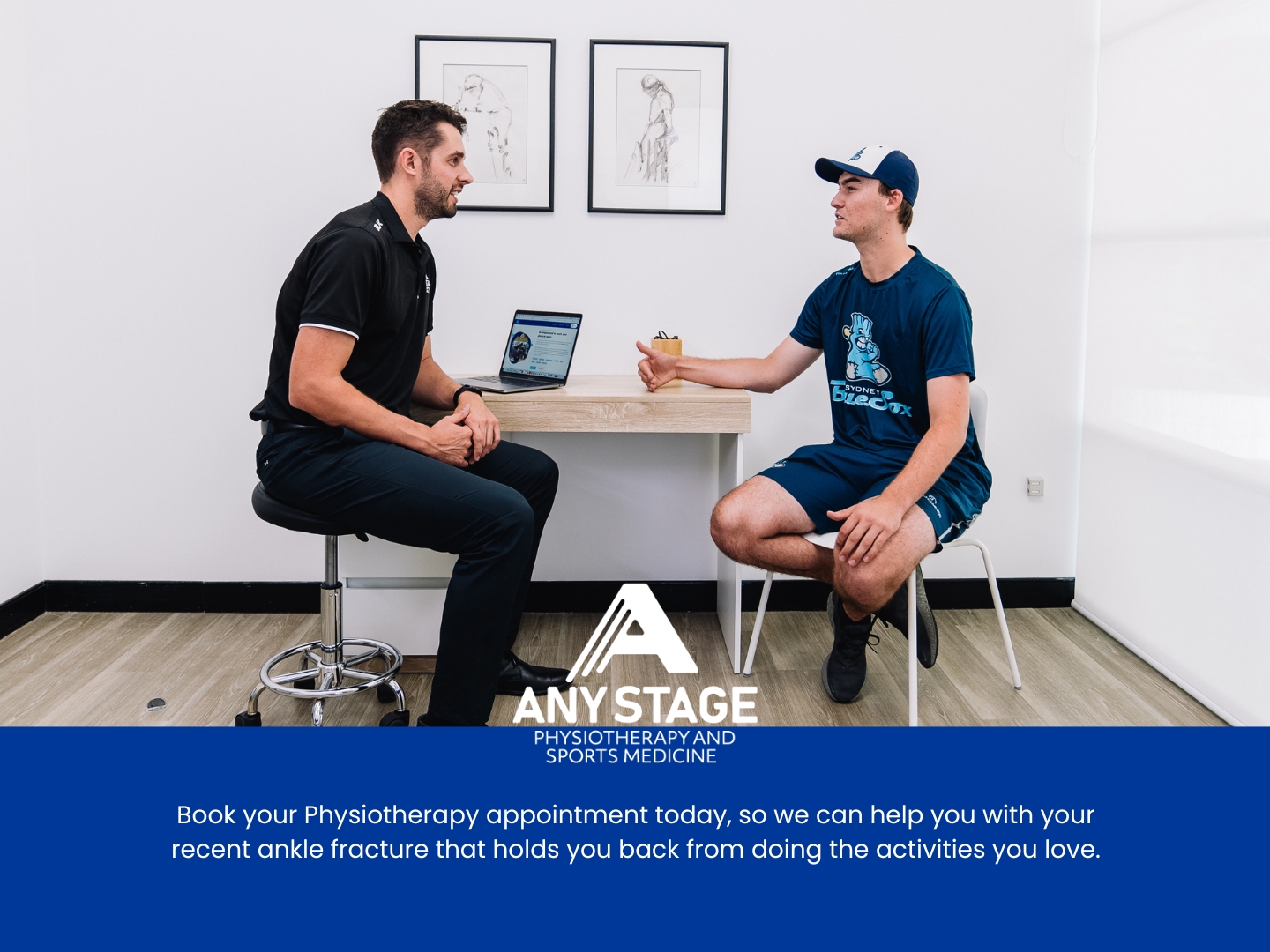This blog will outline the most common fractures experienced in the ankle and foot:
- Ankle (Weber) Fracture
- Base of the 5th Metatarsal (Jones) fracture
- Stress fractures
Ankle (Weber) fractures
An ankle fracture refers to a break or fracture in one or more of the bones that make up the ankle joint. The ankle joint is composed of three bones: the tibia (shinbone), the fibula (smaller bone on the outer side of the leg), and the talus (a bone that sits on top of the heel bone). Ankle fractures can occur in any of these bones, and the severity and treatment of the fracture depends on the specific location and characteristics of the break.
Causes of Ankle Fractures
Ankle fractures can happen due to various causes, including:
- Trauma: A direct blow to the ankle, such as from a fall, car accident, or sports-related injury, causing the bones to fracture.
- Twisting or Rolling: Ankle fractures can occur when the ankle twists or rolls excessively, causing the bones to be placed under abnormal stress, resulting in a fracture.
- Stress Fractures: Overuse or repetitive stress on the ankle, often seen in athletes or individuals engaged in activities with repetitive impact, can lead to stress fractures. These are small cracks or fractures that develop over time due to cumulative stress.
Symptoms of Ankle Fractures
The signs and symptoms of an ankle fracture may include:
- Severe pain at the site of the fracture.
- Swelling and bruising around the ankle.
- Inability to weight bear on the affected leg.
- Deformity or misalignment of the ankle.
- Difficulty or inability to move the ankle joint.
- Tenderness and sensitivity when touching the ankle.
To diagnose an ankle fracture, our physiotherapy staff carry out a systematic assessment and may order imaging tests, such as weight bearing X-rays or sometimes MRI scans, to evaluate the extent and location of the fracture.
The Ottawa Ankle Rules
These rules are clinical guidelines used to determine the need for X-ray imaging in patients with acute ankle injuries. They consist of a set of criteria that can help identify which patients are at a higher risk of having a fracture and, therefore, require X-ray imaging.
The guidelines are as follows:
- Bony tenderness along distal 6 cm of posterior edge of fibula or tip of lateral malleolus (significant tenderness along the bottom 6cm of the outside part of your leg, as well significant pain over your outside ankle bone).
- Bony tenderness along distal 6 cm of posterior edge of tibia/tip of medial malleolus (significant tenderness along the bottom 6cm of the inside part of your leg, as well significant pain over your inside ankle bone).
- Bony tenderness at the base of 5th metatarsal (the base of your littale toe)
- Bony tenderness at the navicular (Tenderness over a specific bone on the inside part of your foot)
- Inability to weight bear both immediately after the injury and for 4 steps during the initial physiotherapy evaluation
If a patient meets any of these criteria, an X-ray is recommended to assess for possible fractures.
Ankle fracture classification system
If an ankle fracture occurs, it is typically classified based on location of the affected bone in a Weber classification system. The Weber classification includes three main types of fractures:
- Weber A Fracture: In a Weber A fracture, the fracture line is located below the level of the syndesmosis (the joint between the tibia and fibula). Specifically, the fracture occurs just above the level of the ankle joint or slightly below it. These fractures are typically stable, with the ankle joint remaining aligned. Treatment for Weber A fractures usually involves conservative measures, such as immobilisation with a cast, brace or boot, and they generally have a good prognosis.
- Weber B Fracture: Weber B fractures occur when the fracture line extends above the level of the syndesmosis, typically at the level of the fibula or slightly higher. These fractures can be unstable and may involve some disruption of the syndesmosis (Syndesmosis blog). The stability of the fracture depends on factors such as the degree of displacement and the integrity of the syndesmotic ligaments. Treatment for Weber B fractures may involve nonsurgical or surgical interventions, depending on the specific characteristics of the fracture and the patient’s individual circumstances.
- Weber C Fracture: Weber C fractures are the most severe type of Weber fracture. They involve a fracture line above the syndesmosis, often at the level of the tibia or higher. These fractures are typically associated with significant instability and complete disruption of the syndesmotic ligaments. Treatment for Weber C fractures usually involves surgical intervention to realign and stabilise the fractured bones. Fixation devices such as screws, plates, or rods may be used to stabilise the ankle joint during the healing process.
Physiotherapy following an ankle fracture
Following the initial treatment, rehabilitation and physiotherapy play a crucial role in ankle fracture recovery. Physiotherapy helps restore range of motion, strengthen the ankle and surrounding muscles, improve balance and proprioception, and facilitate a safe return to activities and sports.
The recovery time for an ankle fracture varies depending on the severity of the fracture, the treatment approach, and individual factors. In general, it can take several weeks to several months for the bones to heal and for the individual to regain full function of the ankle joint. During the recovery process, gradual weight-bearing and mobility exercises are introduced when tolerated and will be guided by your physiotherapist and/or orthopaedic specialist.
Base of fifth metatarsal fracture (base of little toe)
A Jones fracture is a specific type of fracture that occurs in the fifth metatarsal bone of the foot, which is the long bone on the outer side of the foot that connects to the small toe.
The Jones fracture is characterized by a break or fracture at the base of the fifth metatarsal, specifically in an area called the metaphyseal-diaphyseal junction. This area has a relatively poor blood supply compared to other parts of the bone, which can make the healing process more challenging.
Jones fractures most commonly occur due to an acute traumatic injury, such as a sudden twisting motion or a direct blow to the foot. They can also result from repetitive stress or overuse, particularly in athletes engaged in activities that involve running, jumping, or pivoting movements.
The Ottawa Ankle Rules are also applied for the Jones fracture in the decision-making of the necessity for an x-ray if a fracture is suspected. As mentioned above, the following assessment is critical in guiding the next plan treatment:
Bony tenderness at the base of the 5th metatarsal (the base of your little toe)
An X-ray is indicated if there is any pain in the midfoot zone (the area in the middle of the foot), and any of the following are present:
- Bone tenderness at the base of the fifth metatarsal (the long bone on the outer side of the foot)
- Inability to bear weight immediately after the injury and in the emergency department (four steps).
Treatment of the Jones fracture will depend on the severity and stability of the fracture. Typically, a boot is needed with weight-bearing as tolerated. Initially, crutches may be helpful to offload when pain is too severe. Healing timeframes will be subject to severity, but also adherence to the protocol for this type of fracture. If not effectively immobilised and protected, non-union (healing) of the bone may occur due to the poor blood supply to the base of the 5th metatarsal. Range of motion and strength exercises as tolerated will be commenced when safe and directed by the orthopaedic specialist or physiotherapist.
Stress Fractures
Stress fractures of the ankle and foot are small cracks or breaks in the bones caused by repetitive stress and overuse rather than a single traumatic event. They commonly occur in athletes or individuals engaged in activities that involve repetitive impact or high levels of stress on the feet and ankles.
The bones of the ankle and foot are susceptible to stress fractures due to the repetitive loading and strain they endure during weight-bearing activities. Stress fractures can occur in various bones, including the metatarsals (bones of the forefoot), the navicular bone, the calcaneus (heel bone), and the talus (bone between the leg and the foot).
Symptoms of Stress Fractures
The signs and symptoms of stress fractures in the ankle and foot can vary but typically include:
- Pain: Gradual onset of localised pain that worsens with activity and improves with rest. The pain may be dull, aching, or sharp. Often pain at night that wakes you up can indicate a stress fracture.
- Swelling: Mild to moderate swelling around the affected area.
- Tenderness: Specific points of tenderness over the site of the stress fracture.
- Pain with weight-bearing: Increased pain during activities that put stress on the affected bone, such as walking, running, or jumping.
- Changes in walking gait: Altered walking pattern or gait to minimise weight-bearing on the affected foot or ankle.
Treatment for stress fractures of the ankle and foot
Treatment generally involves a combination of rest, activity modification, load management, and supportive measures to promote healing. The specific treatment approach may include:
- Rest and immobilisation: The affected foot or ankle may need to be immobilised with a cast, walking boot, or crutches to minimise weight-bearing and allow the bone to heal.
- Pain management: Nonsteroidal anti-inflammatory drugs (NSAIDs) or other pain medications may be recommended to alleviate pain and inflammation. (Please consult with her medical doctor before taking any medications).
- Activity modification / load management: Avoiding or modifying activities that cause pain or stress on the affected area is crucial during the healing process.
- Rehabilitation: Once the fracture begins to heal, a gradual return to weight-bearing activities and a structured rehabilitation program will be prescribed to restore strength, flexibility, and function of the ankle and foot.


The recovery time for stress fractures of the ankle and foot can vary depending on the location and severity of the fracture, adherence to treatment protocols, and individual healing factors. It typically takes several weeks to several months for the bone to heal completely. It’s important to closely follow the guidance of a healthcare professional, including regular follow-up visits, imaging studies, and adherence to rehabilitation programs, to ensure optimal healing and prevent complications.
Final thoughts on foot and ankle fractures
If you have experienced a recent ankle fracture, or, having difficulty returning to sport/lifestyle following a fracture, please do hesitate to contact our friendly and experienced team at Any Stage Physiotherapy and Sports Medicine.
Authors


Daniel Lee
DPT, B. Sc, APAM
Director / Principal Physiotherapist
Daniel Lee has created a specialised approach to Physiotherapy treatment, return to sport and injury prevention by incorporating a functional strength & conditioning approach, no matter the individual’s age, sport, lifestyle, or competition level.

Shannon Murray
DPT, B. HSc, APAM
Physiotherapist
Shannon completed her Doctor of Physiotherapy degree at Macquarie University, after relocating from Queensland, where she completed her Bachelor of Health Science degree. Whilst completing her Doctor of Physiotherapy degree, she gained valuable experience in various setting, including private practice and hospital.









